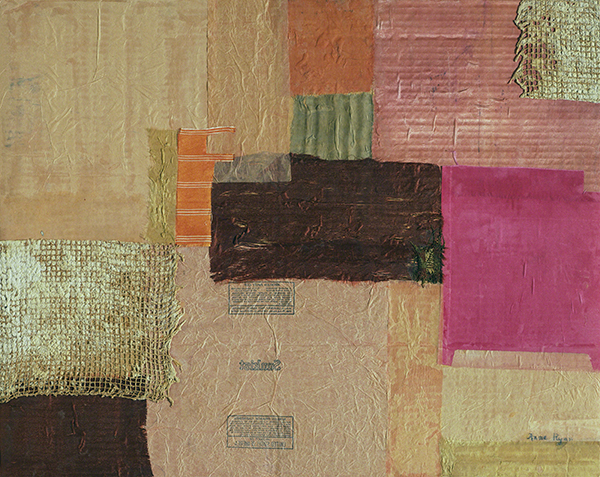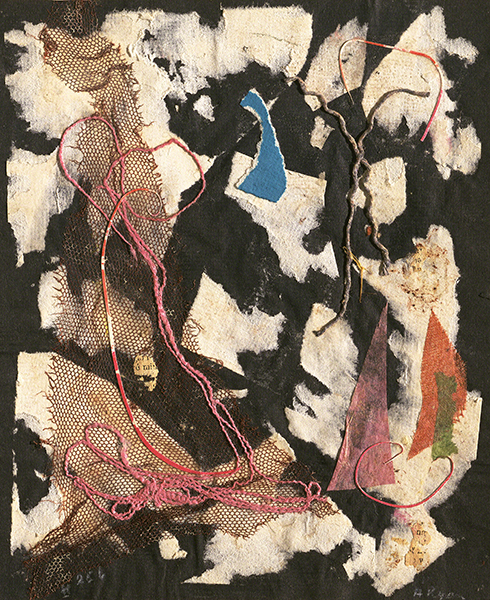Gem for Pride Month 2023: Anne Ryan
Our Gem for this Pride Month is Anne Ryan, an artist who was one of the first women who dedicated a large portion of her body of work to collage. She was one of the many gay artists who were active around the time Abstract Expressionism began to take the art world by storm as the first home-grown modernist movement.
 |
| Anne Ryan (1889–1954, U.S.), Number 706 (Red Collage III), 1954. Collage of pasted plain and printed paper and cloth, 21 1/8" x 26 ½" (53.7 x 67.4 cm). Courtesy of the Museum of Modern Art, New York. © 2023 Artist or Estate of Artist. (MOMA-P2933) |
After seeing the collages of Kurt Schwitters (1887–1948) exhibited in 1948 in New York, Ryan began an extensive, although short-lived, exploration of that genre. Schwitters pioneered the medium as fine art during the late teens and 1920s. Referring to his collages as “Merz Pictures,” Schwitters was fond of contrasting different types of textured or hand-marked papers. His influence is obvious Ryan’s Number 706 (Red Collage III). This work was part of a 2010 exhibition at the Metropolitan Museum in New York called The Prismatic Eye: Collages by Anne Ryan, 1948–1954.
Between the 1880s and 1920s, many American artists journeyed to Europe—particularly Paris—to learn about the most progressive modernist movements. The enthusiasm for abstraction and abstraction-influenced art waned after World War I (1914–1918) when Americans were no longer interested in anything European after American involvement in the disastrous war. Interest in modern art fizzled almost altogether when the Great Depression (1929–1940), a severe world-wide economic downturn, caused Americans to become even more isolationist and introspective.
The government-funded Federal Art Project helped keep unemployed artists working starting in 1935, but the government did not sanction abstraction. It was believed that the American public desired uplifting, realistic art of American life. The 1930s, however, did see the immigration of many European abstract artists to the U.S. because of the rise of Nazi power.
The first exhibition of abstract and Cubist art at the relatively new Museum of Modern Art in New York in 1936 featured only European artists. The group Abstract American Artists (AAA) was founded the same year in New York to counter that trend and provide a voice for American artists who persisted in pursuing abstraction. Despite the prevalence of Social Realism and Regionalism during the 1930s, there were quite a number of artists who pursued personal types of abstraction. Many of those artists were women, including founding members of the AAA.
Ryan was born and raised in Hoboken, New Jersey. From the 1920s on she lived in Greenwich Village, New York. There, her circle of friends included many artists who would pioneer a modern American painting school: Jackson Pollock (1912–1956), Barnett Newman (1905–1970), and Hans Hofmann (1880–1966). In the late 1930s, she was encouraged by Hofmann to try painting. She took it up in 1938 at the age of 50. She does not seem to have had any artistic training until 1941, when she took printmaking courses at Atelier 17 in New York. Her first one-woman show of paintings was in 1941.
The late 1940s witnessed Ryan’s perfection of the white-line woodcut technique. Although producing work in the midst of the boom of Abstract Expressionism, Ryan was never tempted to work on such grandiose scale or with the philosophical bent of their work. As she developed her collage process, she emulated those of Schwitters, incorporating bits of text along with scraps of thrown-away materials.
Eventually abandoning such "precious" elements as bits of text in her work, Ryan concentrated on more formal elements of composition in her collages. She collected a variety of fabrics, preferring them to be distressed, combined with materials such as cardboard, foil, or cellophane. These Ryan arranged in usually compact, textured, modestly sized works. She often mounted the materials on handmade paper and added touches of pastel or pigment to the finished collage.
Another exciting work from this prodigious collage period of 1948 to 1954 is Number 256. In this work, Ryan has clearly eschewed any components containing bold text in order to concentrate on the ideas of texture, asymmetrical balance, and unity.
 |
| Anne Ryan, Number 256, 1949. Pasted colored and printed papers, cloth and string on paper, 6 ¾" x 5 ½" (17 x 14 cm). Courtesy of the Museum of Modern Art, New York. © 2023 Artist or Estate of Artist. (MOMA-P2529) |
Correlations to Davis programs: Experience Art: 3.3; The Visual Experience 4E: 8.5; Experience Painting: Chapter 9


Comments